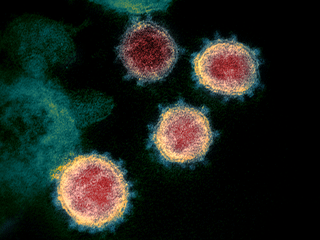
This transmission electron microscopic image shows SARS-CoV-2, also known as 2019-nCoV, the virus that causes COVID-19. (Image courtesy of NIH/NIAID. License: CC BY).
Resource Description
Resource Features
Course Description
This resource is a collection of videos taught using a LightBoard, a specialized glass that creates a transparent white board. It teaches scientific principles to quantitatively assess the risk of airborne transmission of COVID-19 in indoor spaces based on factors such as the occupancy, time, room geometry, mask use, ventilation, air filtration, humidity, respiratory activities, etc., as well as how these factors interact. This collection is suitable for learners with some undergraduate-level training in STEM, although some videos may also be accessible to the general public. Graduate students and professionals can watch optional videos with more challenging mathematics. The full course with problems is available for free on edX with this MITx course: Physics of COVID-19 Transmission.


